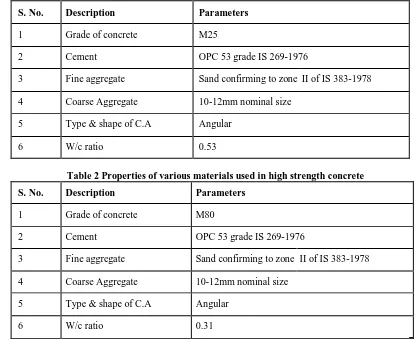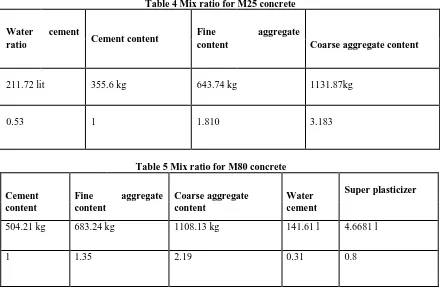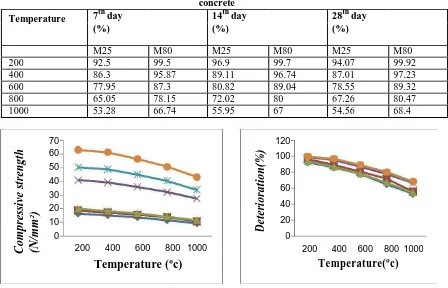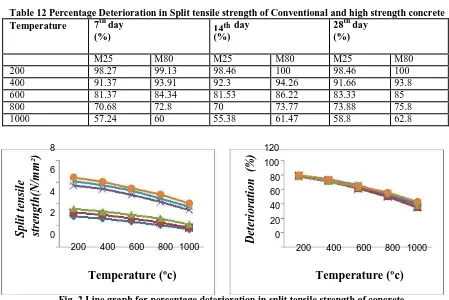Evaluation of Rate of Deterioration in
Various Concrete
R.A.Priyadarshini 1, Gowri.R 2, Asha.R.M 3
Assistant Professor, Department of Civil Engineering, Sri Sairam Institute of Technology, Chennai, India 1
Assistant Professor, Department of Civil Engineering, Sri Sairam Institute of Technology, Chennai, India 2
Assistant Professor, Department of Civil Engineering, Sri Sairam Institute of Technology, Chennai, India 3
ABSTRACT: The extensive use of concrete as a structural material has lead to the demand to fully understand the effect of fire on concrete. With the evolution of High Strength Concrete (HSC), questions have arisen as to whether this type of concrete can still be effective as a fire proofing material. As concrete is exposed to elevated temperatures in fire, its mechanical properties such as strength and modulus of elasticity may be decreased remarkably and results in undesirable fractures and spalling. Although a great deal of research has been conducted on the fire resistance of concrete, since HSC is a relatively new type of concrete, knowledge about the performance of HSC that too with blended cement subjected to fire is limited in comparison with Normal Strength Concrete (NSC).
A recent review of fire performance of HSC identifies that HSC differs from NSC with respect to relative strength loss and the occurrence of explosive spalling in HSC. An attempt has been made in this work to study the effect of elevated temperatures (up to 1000°C) on compressive strength of HSC of M80 grade using ordinary Portland cement. High strength concrete specimens were exposed to different temperatures of 200°C to 1000°C duration of 1hour. After exposing the specimens to elevated temperatures, they were tested for their strength in hot state. Then effect of elevated temperatures on strength of HSC was assessed.
KEYWORDS: High strength concrete, conventional concrete, temperature, split tensile strength, flexural strength.
I. INTRODUCTION
The twentieth century has brought about much technological advancement in all areas of life, including construction. High-strength concrete (HSC) is the current state-of-the-art in concrete construction. HSC is a truly efficient building material continually being pushed to ever-greater strengths and newer used by leading professionals. And it is poised for even further development in the 21st century and beyond. High-strength concrete as we know it today in the ready mix and precast industries is the result of ongoing research and development to optimize concrete ingredients, proportioning, mixing, placing, and quality control methods.
High strength concrete has a low water cement ratio and higher compressive strength than conventional concrete. To achieve higher workability, super plasticizers are added. The higher compressive strength is the result of admixtures added during mixing.
A USE OF HIGH STRENGTH CONCRETE
Strength: Use of high strength concrete can make concrete construction a viable economic alternative to steel frames in certain high rise buildings. In such cases normal strength requires excessively large column sizes.
some high strength concretes.
Durability: Reduced permeability of higher strength concretes can help deter chemical attack, and improve abrasion resistance.
II. OBJECTIVE
The main objective of this thesis is to arrive at the mix ratio M80 for high strength concrete and M25 for normal concrete. To compare and analyse the rate of deterioration of high strength and normal concrete. Usage of high strength concrete has been increasing day by day in construction industry. Therefore investigations on its deterioration will be of great use, keeping in view of the life of the structure.
III. PROPERTIES OF MATERIALS
The properties of various materials used in both conventional and high strength concrete are tabulated below
Table 1 Properties of various materials used in conventional concrete
S. No. Description Parameters
1 Grade of concrete M25
2 Cement OPC 53 grade IS 269-1976
3 Fine aggregate Sand confirming to zone II of IS 383-1978
4 Coarse Aggregate 10-12mm nominal size
5 Type & shape of C.A Angular
6 W/c ratio 0.53
Table 2 Properties of various materials used in high strength concrete
S. No. Description Parameters
1 Grade of concrete M80
2 Cement OPC 53 grade IS 269-1976
3 Fine aggregate Sand confirming to zone II of IS 383-1978
4 Coarse Aggregate 10-12mm nominal size
IV. TESTS ON MATERIALS
Various test are conducted on different materials like cement, sand, coarse aggregate and the values are tabulated below:
Table 3 Test on various materials
S.NO TEST RESULT
1 Normal consistency of the cement 29 %
2 Initial setting time of cement 25 min
3 Specific gravity of cement 3.60
4 Fineness of cement sample 98.27%
5 Specific gravity of sand 2.47
6 Specific gravity of coarse aggregate 2.91
V. DESIGN MIX
Mix design for M25 and M80 concrete is derived and the mix ratios are tabulated below
Table 4 Mix ratio for M25 concrete
Water cement
Cement content Fine aggregate
Coarse aggregate content
ratio content
211.72 lit 355.6 kg 643.74 kg 1131.87kg
0.53 1 1.810 3.183
Table 5 Mix ratio for M80 concrete
Cement Fine aggregate Coarse aggregate Water Super plasticizer
content content content cement
504.21 kg 683.24 kg 1108.13 kg 141.61 l 4.6681 l
VI. RESULTS
A Compressive strength
Compressive strength of a concrete is a measure of its ability to resist static load, which tends to crush it. Most common test on hardened concrete is compressive strength test Compressive strength is one of the important properties of concrete. Conventional Concrete cubes of size 100x100x100mm were casted. After 24 hours the specimen were demoulded and subjected to water curing. After 7, 14 & 28 days curing three cubes were taken and allowed to dry and tested in compressive strength testing machine.
Table 6 Compressive strength of conventional and high strength concrete
Age of curing Conventional concrete M25 (N/mm²) High strength concrete M80 (N/mm²) (Days)
7 17.83 41.2
14 19.30 50.65
28 21.26 63.25
B. Tensile strength
Tensile strength of a concrete is a measure of its ability to resist forces, which stretch or bend it. Specimens of size 200x100mm were casted. After 24 hours the specimen were demoulded and subjected to water curing. After 7, 14 & 28 days curing three cubes were taken and allowed to dry and tested in split tensile strength testing machine.
Table 7 Split tensile strength of conventional and high strength concrete
Age of curing Conventional concrete M25 (N/mm²) High strength concrete M80 (N/mm²) (Days)
7 2.9 5.75
14 3.25 6.1
28 3.6 6.45
C Flexural strength
The specimen is placed in universal testing machine and the load is to be applied without shock until the specimen fails and the maximum load applied to the specimen during the test is to be recorded.
Table 8 Flexural strength of conventional and high strength concrete
Age of curing Conventional concrete M25 (N/mm²) High strength concrete M80 (N/mm²) (Days)
7 3.45 6.8
14 3.7 7.15
28 4.16 7.35
D. COMPRESSIVE STRENGTH OF DETERIORTED CONCRETE AND PERCENTAGE DETERIORATION Cured specimens of 7, 14 and 28 days were kept in oven at different temperatures such as 200, 400, 600, 800,
Temperature (ºc)
Table 9 Compressive strength of conventional and high strength concrete after deterioration
Temperature 7th day 14th day 28th day
(N/mm²) (N/mm²) (N/mm²)
M25 M80 M25 M80 M25 M80
200 16.5 41 18.7 50.5 20 63.2
400 15.4 39.5 17.2 49 18.5 61.5
600 13.9 36 15.6 45.1 16.7 56.5
800 11.6 32.2 13.9 40.5 14.3 50.85
1000 9.5 27.5 10.8 33.9 11.6 43.26
Table 10 Percentage Deterioration in compressive strength of conventional and high strength concrete
Temperature 7th day 14th day 28th day
(%) (%) (%)
M25 M80 M25 M80 M25 M80
200 92.5 99.5 96.9 99.7 94.07 99.92
400 86.3 95.87 89.11 96.74 87.01 97.23
600 77.95 87.3 80.82 89.04 78.55 89.32
800 65.05 78.15 72.02 80 67.26 80.47
1000 53.28 66.74 55.95 67 54.56 68.4
Fig.1 Line graph for percentage deterioration for compressive strength of concrete
E. SPLIT TENSILE STRENGTH OF DETERIORTED CONCRETE AND PERCENTAGE DETERIORATION Cured specimens of 7, 14 and 28 days were kept in oven at different temperatures such as 200, 400, 600, 800,
1000ºc. Specimens are heated for 1 hour, after it was cooled in room temperature for some time. Split tensile strength test on the specimens were carried out.
70
C
om
p
re
ss
iv
e
st
re
n
g
th
60 50 40 30(N/
m
m
²)
20 10 0200 400 600 800 1000
120
D
et
er
io
rat
io
n(
%
)
10080 60 40 20 0
200 400 600 800 1000
Temperature (ºc)
Temperature (ºc)
Table 11 Split tensile strength of conventional and high strength concrete after deterioration
Temperature 7th day 14th day 28th day
(N/mm²) (N/mm²) (N/mm²)
M25 M80 M25 M80 M25 M80
200 2.85 5.7 3.2 6.1 3.56 6.45
400 2.65 5.4 3 5.75 3.3 6.05
600 2.36 4.85 2.65 5.26 3 5.45
800 2.05 4.19 2.29 4.5 2.66 4.89
1000 1.66 3.45 1.8 3.75 2.12 4.05
Table 12 Percentage Deterioration in Split tensile strength of Conventional and high strength concrete
Temperature 7th day 14th day 28th day
(%) (%) (%)
M25 M80 M25 M80 M25 M80
200 98.27 99.13 98.46 100 98.46 100
400 91.37 93.91 92.3 94.26 91.66 93.8
600 81.37 84.34 81.53 86.22 83.33 85
800 70.68 72.8 70 73.77 73.88 75.8
1000 57.24 60 55.38 61.47 58.8 62.8
Fig. 2 Line graph for percentage deterioration in split tensile strength of concrete
F FLEXURAL STRENGTH OF DETERIORTED CONCRETE AND PERCENTAGE DETERIORATION
Cured specimens of 7, 14 and 28 days were kept in oven at different temperatures such as 200, 400, 600, 800, 1000ºc. Specimens are heated for 1 hour, after it was cooled in room temperature for some time. Flexural strength test on the specimens were carried out.
8
st
re
ng
th(
N/
m
m
²)
6
S
pl
it
t
en
si
le
4
2
0
200 400 600 800 1000
120
(%
)
100
D
et
er
io
rat
io
n
8060 40 20 0
Table 13 Flexural strength of conventional and high strength concrete after deterioration
Temperature 7th day 14th day 28th day
(N/mm²) (N/mm²) (N/mm²)
M25 M80 M25 M80 M25 M80
200 3.4 6.8 3.65 7.15 4.1 7.35
400 3.15 6.35 3.4 6.75 3.85 6.95
600 2.76 5.8 3 6.16 3.36 6.29
800 2.23 4.96 2.58 5.25 2.9 5.48
1000 1.86 4.38 2.05 4.68 2.3 4.92
Table 14 Percentage Deterioration in flexural strength of conventional and high strength concrete
Temperature 7th day 14th day 28th day
(%) (%) (%)
M25 M80 M25 M80 M25 M80
200 98.55 100 98.9 100 98.55 100
400 91.3 93.38 91.89 94.4 92.5 94.55
600 80 88.29 81.08 86 80.76 85.5
800 64.63 73.1 67.56 73.42 69.7 74.55
1000 54 64.4 55.4 65.45 55.28 64.25
8 120
F
le
x
u
ral
s
tr
en
g
th
D
et
er
io
rat
io
n
(
%
)
1006
80
4 60
(N/
m
m
²)
40 2
20
0 0
200 400 600 800 1000 200 400 600 800 1000
Temperature(ºc)
Temperature (ºc)
Fig 3 Line graph for percentage deterioration for flexural strength of concrete
VII. CONCLUSION
From the experiment results, the following conclusions were drawn
original strength, especially at temperatures above 600ºC, there is a rapid deterioration in strength of concrete.
Therefore, it is only within the range of 400 to 800ºC that research efforts can be carried out to reduce the strength loss and improve the thermal behavior of concrete.
Upto 200ºC high strength concrete is used where temperature resistancy is required.
REFERENCES
1. A.Kilic., C.D. Atis and A.Teymen (2008), ‘The influence of aggregate type on the strength of abrasion resistance on high strength concrete’. Cement and concrete composites vol-30, pp 290-296.
2. M.A Megat johari., J.J. Brooks and Shahid kabir(2011),’Influence of supllementary cementitious
materials on engineering properties of high strength concrete’. Construction and building materials vol-25, pp 2639-2648.
3. Sammy Y.N.Chan and Gai-fei Peng (1996), ‘Comparison between high strength concrete and normal concrete subjected to high temperature’. Materials and structures vol-29, pp 616-619.
4. Stefan Jacobsen and Erik J.Sellevold (1996), ‘Self healing of high strength concrete after deterioration by freeze/thaw’. Cement and concrete research, vol -26, pp 55-62.
5. Ali Behnood and Hasan Ziari (2008), ‘Effects of silica fume addition and water to cement to cement ratio on the properties of HSC after exposure to high temperatures’. Cement and concrete composites , vol-30, pp 106-112
6. G.Sanjayan and L.J.Stocks (1993), ‘Spalling of high strength silica fume concrete in fire’. ACI materials journal, vol -90, pp 170-173. 7. Min-Hong Zhang and odd E. Gjorv (1991), ‘Characteristics of lightweight aggregates for high strengthconcrete’. ACI materials journal,
vol-88, pp 150-158.
8. V.S Vani., P.S.N Raju and K. Srinivasa rao (2011), ‘Performance of standard and high strength concrete exposed to exposed to elevated temperature’. CE&CR, pp 94-99.
9. Wakchaure, M.R., Er. Shaikh, A.P. and Er. Gite, B.E. (2012), “Effect of types of fine aggregate on mechanical properties of cement concrete”, Int. J. Modern Eng. Res., 2(5), 3723-3726.
10. Bouziani, T., Bederina, M., Hadjoudja, M. (2012), “Effect of dune sand on the properties of flowing sandconcrete (FSC)”, Int. J. Concrete Struct. Mater., 6(1), 59-64.
11. Chuang, T.J., Rudnicki, J. and Multiscale, W. (2001), “Deformation and Fracture in Materials and Structures”, The James R. Rice, 60th anniversary volume.





